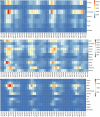Spatiotemporal patterns and risk mapping of provincial hand, foot, and mouth disease in mainland China, 2014-2017
- PMID: 38344231
- PMCID: PMC10853440
- DOI: 10.3389/fpubh.2024.1291361
Spatiotemporal patterns and risk mapping of provincial hand, foot, and mouth disease in mainland China, 2014-2017
Abstract
Background: Hand, foot, and mouth disease (HFMD) has remained a serious public health threat since its first outbreak in China. Analyzing the province-level spatiotemporal distribution of HFMD and mapping the relative risk in mainland China will help determine high-risk provinces and periods of infection outbreaks for use in formulating new priority areas for prevention and control of this disease. Furthermore, our study examined the effect of air pollution on HFMD nationwide, which few studies have done thus far.
Methods: Data were collected on the number of provincial monthly HFMD infections, air pollution, meteorological variables, and socioeconomic variables from 2014 to 2017 in mainland China. We used spatial autocorrelation to determine the aggregate distribution of HFMD incidence. Spatiotemporal patterns of HFMD were analyzed, risk maps were developed using the Bayesian spatiotemporal model, and the impact of potential influencing factors on HFMD was assessed.
Results: In our study, from 2014 to 2017, the HFMD annual incidence rate in all provinces of mainland China ranged from 138.80 to 203.15 per 100,000 people, with an average annual incidence rate of 165.86. The temporal risk of HFMD for 31 Chinese provinces exhibited cyclical and seasonal characteristics. The southern and eastern provinces had the highest spatial relative risk (RR > 3) from 2014 to 2017. The HFMD incidence risk in provinces (Hunan, Hubei, and Chongqing) located in central China increased over time. Among the meteorological variables, except for the mean two-minute wind speed (RR 0.6878; 95% CI 0.5841, 0.8042), all other variables were risk factors for HFMD. High GDP per capita (RR 0.9922; 95% CI 0.9841, 0.9999) was a protective factor against HFMD. The higher the birth rate was (RR 1.0657; 95% CI 1.0185, 1.1150), the higher the risk of HFMD. Health workers per 1,000 people (RR 1.2010; 95% CI 1.0443, 1.3771) was positively correlated with HFMD.
Conclusions: From 2014 to 2017, the central provinces (Hunan, Hubei, and Chongqing) gradually became high-risk regions for HFMD. The spatiotemporal pattern of HFMD risk may be partially attributed to meteorological and socioeconomic factors. The prevalence of HFMD in the central provinces requires attention, as prevention control efforts should be strengthened there.
Keywords: Bayesian spatiotemporal model; HFMD; influencing factor; risk mapping; spatiotemporal pattern.
Copyright © 2024 Wei, Ma, Zhang, Luo, Yin and Shui.
Conflict of interest statement
The authors declare that the research was conducted in the absence of any commercial or financial relationships that could be construed as a potential conflict of interest.
Figures







Similar articles
-
Spatiotemporal Distribution of Hand, Foot, and Mouth Disease in Guangdong Province, China and Potential Predictors, 2009⁻2012.Int J Environ Res Public Health. 2019 Apr 3;16(7):1191. doi: 10.3390/ijerph16071191. Int J Environ Res Public Health. 2019. PMID: 30987085 Free PMC article.
-
Combined impacts of environmental and socioeconomic covariates on HFMD risk in China: A spatiotemporal heterogeneous perspective.PLoS Negl Trop Dis. 2023 May 19;17(5):e0011286. doi: 10.1371/journal.pntd.0011286. eCollection 2023 May. PLoS Negl Trop Dis. 2023. PMID: 37205641 Free PMC article.
-
Spatial-temporal mapping of hand foot and mouth disease and the long-term effects associated with climate and socio-economic variables in Sichuan Province, China from 2009 to 2013.Sci Total Environ. 2016 Sep 1;563-564:152-9. doi: 10.1016/j.scitotenv.2016.03.159. Epub 2016 Apr 30. Sci Total Environ. 2016. PMID: 27135578
-
Spatiotemporal cluster patterns of hand, foot, and mouth disease at the province level in mainland China, 2011-2018.PLoS One. 2022 Aug 22;17(8):e0270061. doi: 10.1371/journal.pone.0270061. eCollection 2022. PLoS One. 2022. PMID: 35994464 Free PMC article.
-
Association of Short-Term Exposure to Meteorological Factors and Risk of Hand, Foot, and Mouth Disease: A Systematic Review and Meta-Analysis.Int J Environ Res Public Health. 2020 Oct 30;17(21):8017. doi: 10.3390/ijerph17218017. Int J Environ Res Public Health. 2020. PMID: 33143315 Free PMC article.
Cited by
-
First Report of Hand, Foot, and Mouth Disease (HFMD) Outbreak in the West Bank, Palestine: Molecular Characterization of Coxsackievirus A16 (CV-A16).Can J Infect Dis Med Microbiol. 2025 Feb 18;2025:9133821. doi: 10.1155/cjid/9133821. eCollection 2025. Can J Infect Dis Med Microbiol. 2025. PMID: 40007683 Free PMC article.
-
Spatiotemporal Changes and Influencing Factors of Hand, Foot, and Mouth Disease in Guangzhou, China, From 2013 to 2022: Retrospective Analysis.JMIR Public Health Surveill. 2024 Aug 2;10:e58821. doi: 10.2196/58821. JMIR Public Health Surveill. 2024. PMID: 39104051 Free PMC article.
-
Epidemiological characteristics and influencing factors of hand, foot and mouth disease reinfection cases in Jiulongpo District, Chongqing, China, 2009-2023.Front Public Health. 2025 Mar 19;13:1543450. doi: 10.3389/fpubh.2025.1543450. eCollection 2025. Front Public Health. 2025. PMID: 40270726 Free PMC article.
References
-
- BMICC. National Scientific Data Sharing Platform for Population and Health. (2021). Available online at: http://www.bmicc.cn/web/share/home (accessed June 13, 2021).
Publication types
MeSH terms
LinkOut - more resources
Full Text Sources

